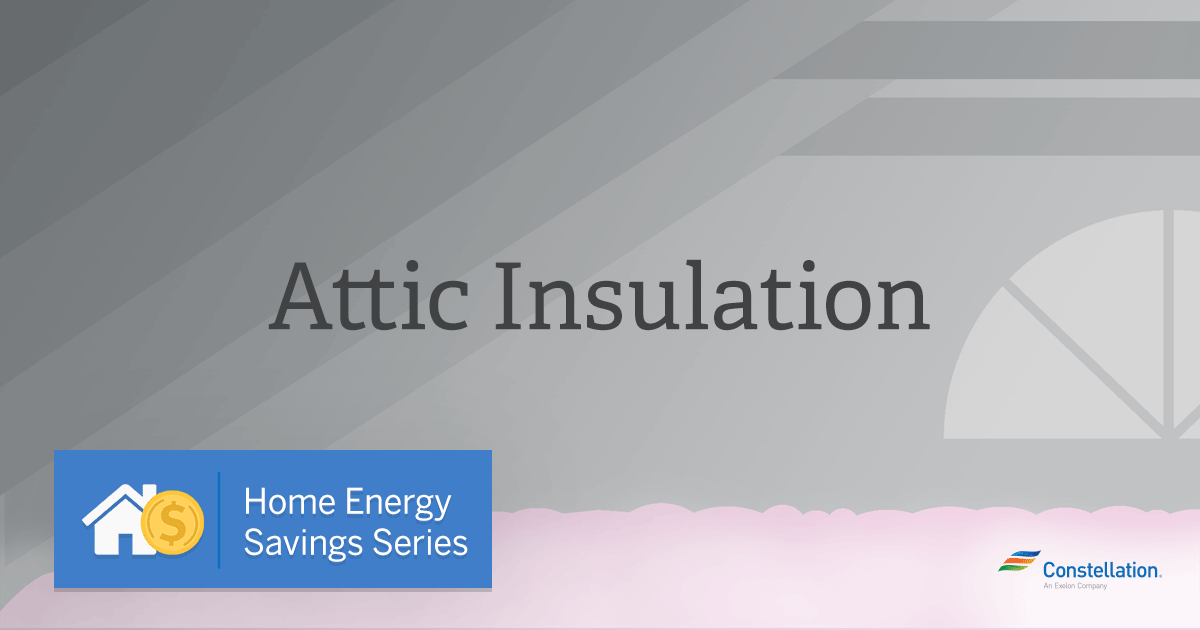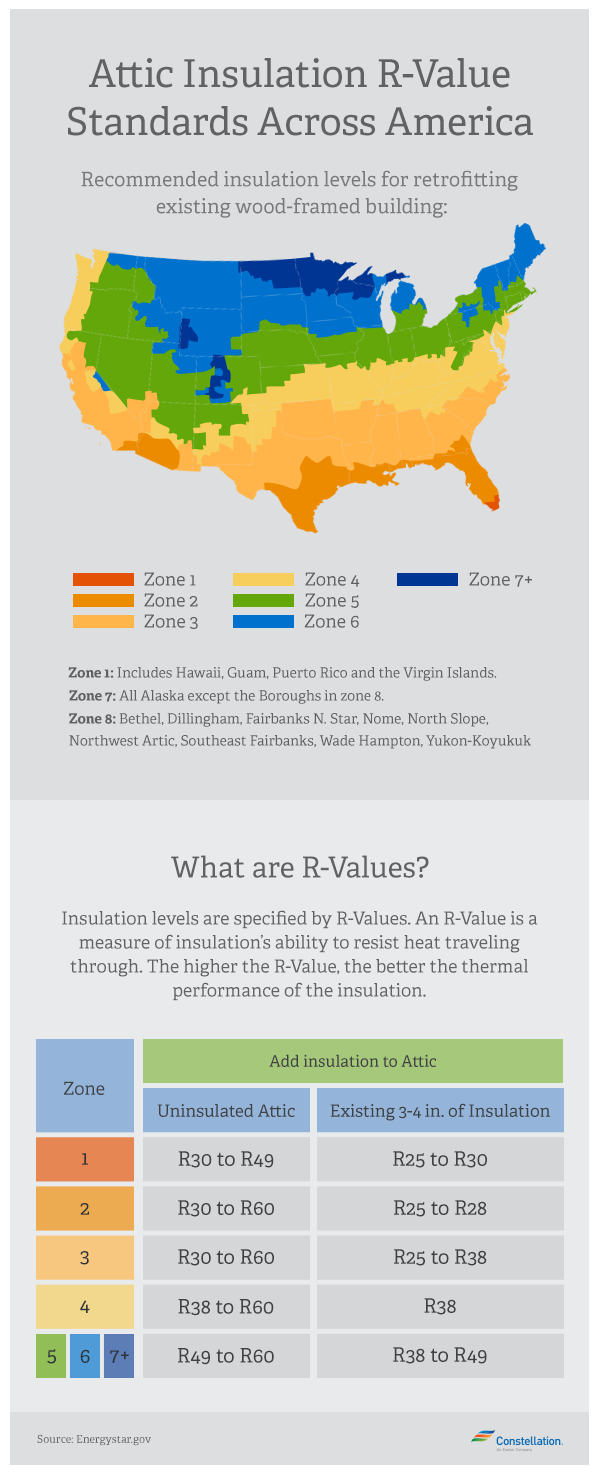
- Category:
Home Energy Savings - Published:
September 9, 2016 - Updated:
May 24, 2018
Home Energy Savings Series: Attic Insulation
Understanding attic insulation types and energy savings
You might be very aware of your energy expenses in the living areas of your home, but it’s important to pay attention to the attic, too, or all your hard work could, literally, blow out the roof. The Department of Energy estimates that you could shave 10 to 50 percent off your heating bill with proper attic insulation. The savings don’t stop there, though — a well-insulated attic helps lower energy usage in spring and summer, too, as it stabilizes a house’s indoor temperatures to keep cooling needs in check.
The first step in looking for attic insulation cost savings is to evaluate the existing materials. Understanding current attic insulation standards is important to evaluating your home’s energy efficiency and determining what attic insulation types make the most sense if you’re looking to upgrade. Not all homes are built with the same materials; you might not even know for sure if you’re using mineral wool vs. fiberglass insulation, for example. Or, you might not be familiar with the various types of blown-in attic insulation and how to choose the most effective for your house.
Understanding attic insulation R-value
Whether you’re looking at material for your basement, interior walls, or attic, insulation R-value tells you material’s ability to resist transmitting heat. If your attic insulation R-value is correct for your house, it means that you’re likely working at high efficiency based on the current attic insulation standards.
Having the right amount of insulation is important for both cold and warm climates because warm air travels to cooler air. So if you’re trying to keep your house cool in summer, good insulation keeps the hot air outside where you want it. If you’re trying to stay toasty in the winter, an adequate attic insulation R-value in your home can help ensure the heat stays inside rather than leaking out the roof and other areas. (Learning how to check and fix air leaks generally is another smart energy cost savings move you can make.)
The higher the R-value, the better the heat resistance of the insulation and the more likely you’ll achieve the attic insulation savings you want. Energy.gov provides some suggestions for how to discover the R-value of your existing insulation. As a general rule, houses built before the 1970s probably have an R-value of 11 or less, while today’s attic insulation R-value standards call for a rating of 38 or more, depending on the house’s location, according to the DIY Network.
Check the quality of insulation as well. If it’s water-stained, compressed or moldy, it likely is not working properly and you’re likely probably not seeing any attic insulation savings. Consider replacement. If your house was built before 1990, see if the insulation has shiny flecks. These could be vermiculite from a mine with asbestos deposits and should be tested. Only professionals can remove and replace this kind of attic insulation.
Attic Insulation R-Value Standards Across America

How to upgrade for attic insulation savings
In addition to making sure that your home is in keeping with current attic insulation R-value standards, it’s also important to prepare your house for any insulation upgrade. Otherwise, the work you’re doing (or having a professional do) to achieve attic insulation cost savings might be for naught.
- Declutter the attic. Many of us use that upper-level space as storage, but that could work against potential attic insulation cost savings, especially if items are placed in areas that reduce air flow and restrict the insulation from doing its job. This Old House recommends removing some plywood flooring to make room for insulation. Find another spot for those family treasures! We’re sure Aunt Miranda won’t mind if her china sits in the basement, instead, if it means that you’re increasing your attic insulation cost savings!
- Fix roof leaks. Water is insulation’s enemy. It can be a breeding ground for mold and mildew, which in turn ruins the air-trapping pockets that block heat flow. Look for water stains on the roof sheathing or damp or moldy spots on attic joists and existing insulation as a clue to where leaks might be. If there is any moisture or water in your attic, insulation R-value will be reduced and your energy costs could increase. Fix leaks before replacing or adding insulation.
- Box out light fixtures. Unless you’re using mineral-wool insulation, or your fixtures are rated safe for contact with any type of insulation, don’t allow the material to touch or cover recessed cans or lights from the floor below. It’s a fire hazard. You should have a safety gap of at least three inches on all sides of these fixtures. You can use hardware cloth, metal flashing, or scrap plywood to create that gap.
- Be sure all exhaust fans and vents release directly to the exterior. It’s against building code to vent any kind of exhaust to an attic space, but many home builders have gotten away with this shortcut. Fix this so that humid exhaust air doesn’t get trapped in your insulation and ruin it and your chance for attic insulation savings. (See note re. water is insulation’s enemy.)
Attic insulation types
You’ve determined the basics, such as whether you have mineral wool vs. fiberglass insulation (or some other kind altogether), and you understand the ins and outs of attic insulation, R-value standards, and how to prep your attic for the upgrade. Now it’s time to figure out what insulation would do the most effective job. Just like weatherstripping and caulking or any other home improvement, you need to work with the correct materials.
Blown-in attic insulation
If you’re going the professional route and having insulation blown in, you’ll need to consider types of blown-in attic insulation. If you’re installing insulation yourself, This Old House suggests using either batts or loose fill. If you are a serious DIYer, you can tackle blown-in attic insulation yourself. The Family Handyman offers a step-by-step guide. Be prepared to get sweaty and dirty.
The two types of blown-in attic insulation, fiberglass and cellulose, both have an R-value that adds up to about 3 or 4 for every inch applied. Cellulose has the advantage of being made from recycled newspaper and is a greener option for beefing up your attic insulation.
Mineral wool vs. fiberglass insulation batts
Batts come in long strips, while loose fill comes in exactly what it sounds like, loose bits that are stuffed into holes and crevasses and then covered. Both forms come in a variety of materials. Energy.gov has a table of attic insulation types for easy comparison in order to select the most effective type of insulation for different areas of your house.
But, if you’re trying to be environmentally conscious in your attic insulation cost savings you should understand the differences between mineral wool vs. fiberglass insulation made from rockwool. Fiberglass is made from fine strands of woven glass, which are then formed into rolls or blankets that fit wall cavities. It is also available in the loose-fill form.
Rockwool, also available in loose and batt forms, is made from strands of heated rock or minerals instead of glass. It’s an important distinction when comparing mineral wool vs. fiberglass insulation derived from rockwool. The Department of Energy says that the average fiberglass contains 20 to 30 percent recycled material, while rockwool contains 75 percent recycled content, making it a more eco-friendly choice. Rockwool is generally more expensive.
Attic door insulation
Finally, don’t forget the attic door insulation. ENERGY STAR says inadequate attic door insulation is a classic place for air leaking to occur. Be sure that the hatch has appropriate weatherstripping in place. A piece of fiberglass or foam board the same size as the hatchway can also trap any air that might rise before it leaks all the way into the attic.
Want to know more home energy savings tips? Learn how to check and fix air leaks in other parts of your home.




